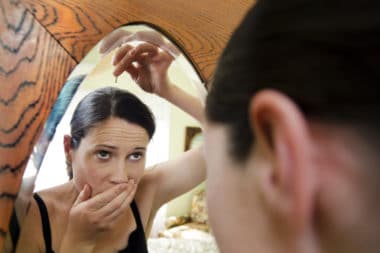Balding is a common occurrence for men between the ages of 20 and 60, and a common concern as well. Androgenic alopecia, the medical term for male pattern baldness, is not curable. However, a few medical treatments exist that help to slow the process. But where does baldness come from? What, or who, is to blame? For a long time, mothers have taken the brunt of the blame, both due to genetics as well as because of things that they did, like scrubbing a child’s head too hard or making them wear hats. However, as science learns more about the mechanism of balding, and more studies about the likelihood of baldness are done, the answer becomes much more complicated than scientists first thought.
Mom’s Role in Baldness: An Intro to Genetics
So for this to make sense, you need to first understand a little bit about how genes are passed on from generation to generation. Here are the basics: In the nucleus of every cell (and another location, called the cell mitochondria) in your body, there are 46 strands of DNA. These strands are different lengths, and they are arranged in 23 pairs. Each of these strands is called a chromosome, and they are where your genes live. Certain genes are always found on the same chromosome, in the same location, unless there has been a mutation. When you reproduce, half of these genes, one member of each of your 23 chromosome pairs, is passed on to your children. The genes are numbered 1-22, and the 23rd chromosome pair, which determines sex, is made up of X chromosomes or X and Y chromosomes.
Scientists believed for a long time that mothers were solely responsible for passing baldness on to their sons. The reason for this is the location of the gene that they found which has a role in male pattern baldness. The gene, located on the X chromosome, can only come from a man’s mother. The reason for this is that women can only give X chromosomes to their children, while men will either give an X chromosome, which creates a daughter, or a Y chromosome, which creates a son. Because of this, every man knows that the X chromosome in their genes comes from mom, and the Y chromosome has to come from dad. If the location of this gene is on the X chromosome, then mom should be completely to blame for your baldness, right? Wrong.
Why it’s More Complicated than Originally Thought
So, here are a few things about this theory that bothered scientists. If a single gene is responsible and it comes from mothers, then why don’t women go bald very often? One argument about this said that the X chromosomes balance each other out, and a non-bald gene is dominant over the bald gene. But wouldn’t all the women who get bald genes from both parents then be bald? There must be more to the story. One likely piece to the puzzle is that it is not one gene, but a combination of genes from different chromosomes that tell the whole genetic baldness story. This is the case with height, hair color and texture and many other physical characteristics. This is why there are common cases where a child can appear that looks nothing like either parent, but bears a strong resemblance to a great grandparent or another ancestor. Recent studies have shown that if there is baldness anywhere in your genetic line, either your mom’s line or your dad’s line, then you are more likely to go bald yourself. So, even if every member of your mother’s ancestry has luxurious, flowing hair into their nineties, your dad’s bald grandfather can still ruin it for you. The chance is slim, but it’s there.
So Why Are You Bald, Then?
There is more to understand if you look at the body’s process of how you become bald. There are two pieces to this equation: If you are going bald, then you have a sensitivity to male hormones and the hair-sprouting cells within follicles that no longer properly develop. Both of these pieces are only now beginning to be understood better. However, they are both key to developing a cure someday.
Sensitivity to Androgens, or Male Hormones
So the first half of why you go bald is your sensitivity to male hormones. This is why male pattern baldness is much more common than female baldness. Though women have some male hormones like testosterone in their body, they occur at much lower levels than they do in men. This sensitivity begins happening after you complete puberty and increases with age. The amount of sensitivity can vary widely from person to person. This is why some men can start balding as early as their twenties, and others don’t begin until they are 50 or older.
Deficient Progenitor Cells in Hair Follicles
This particular aspect of balding has only been discovered since 2015. The University of Pennsylvania medical school did a study which helps to better understand how balding works on a cellular level. It has to do with what happens when old cells die and new cells come in to take their place, which is a normal part of aging. As the cells of a hair follicle die off, nearby stem cells need to differentiate themselves into parts of a follicle once again in order for the follicle to survive and continue producing hairs. When cells are in the stem stage, they can turn into most any type of cell in the body. Progenitor cells are slightly more specific, and though they haven’t yet become their target type of cell, they know which kind of cells they want to become. In a receding hairline, there are plenty of stem cells, but the progenitor cells either don’t form into follicles or they only form part of the way. As a result, there are still hair follicles in a bald scalp, but they are tiny and ineffective. However, this knowledge may be the key to new future cures for male pattern baldness if scientists are able to target the progenitor cells and help them to complete their transition to follicle cells.
Nature vs Nurture: Why Genes Alone Aren’t the Answer
It is important to understand a little bit about the play between genetics and environment. Genes are not an inevitability, even if you have a gene for something. In many cases, genes will determine the range of possibilities that you can have, and your environment and lifestyle choices will determine where you fall on that range. For example, your genes don’t fully determine your height. Instead, your genes will show the range of heights you can fall into, and your diet and lifestyle will make you taller or shorter. The same is true with balding. Though you can’t prevent it completely, you can make certain lifestyle choices which can slow the process or extent of your male pattern baldness. If you are genetically blessed to not be predisposed to balding genes, then it is unlikely that even the worst of these lifestyle choices will make any difference to your hairline.
Hair Loss and Nutrition
This is a controversial topic to some extent, as naturopaths, nutritionists and alternative practitioners may feel more strongly about this than traditional doctors. Some will blame the traditional Western diet for hair loss, claiming that it lacks many of the nutrients needed to keep a head of healthy hair. However, as many of the genes for balding are found in European lineages and not those typical to third-world countries, this is a difficult premise to prove or disprove. Some of the vitamins and minerals that get included in supplements to promote hair health include biotin, niacin, zinc and vitamin C. Hair is formed from keratin, and you need to eat enough protein, the building block for this substance, to form new strands. Drinking green tea is also a recommendation, as the compounds in the tea can block out DHT, one of the androgens that cause baldness. There is a definite medical link to the rate and amount of hair loss and a healthy diet, however, the extent to which it is true will again vary person to person. If you are just beginning to bald, however, it is an easy place to begin trying to lessen the effects of male pattern baldness. General health also plays a role here, including maintaining a healthy BMI, or body mass index. If you want to know where your BMI falls on the health scale, you can enter your height and weight into the calculator here: https://www.healthstatus.com/calculate/body-mass-index.
Hair Loss and Harmful Supplements
It is important to note that many of the bodybuilding supplements are designed to maximize your body’s production of androgens to increase muscle mass production. Since sensitivity to these hormones is a key factor in how rapidly a hairline recedes, you may want to avoid these products if you have hair loss concerns.
Hair Loss and Stress
Doctors have recently been looking into a link between stress and hair loss, partially because there are an unprecedented number of men who are beginning to bald in their twenties, as well as a surge in stress, depression and anxiety. While it is not the main reason, stress can change the hormone levels in the body in a way that maximizes hair-losing androgens and minimizes blood flow and nutrients to the scalp.
Hair Loss and Smoking
One definite link that has been found between lifestyle and baldness is found in cigarettes, pipes, cigars and marijuana products. The problem is not in tobacco, but in the carbon monoxide from the smoke itself. This can displace oxygen in cells, providing less oxygen to aid in cell replication.
Hair Loss and Styling
Doctors are mixed on the link between hair products, excessive styling and baldness. The body is designed to lose between 50 and 100 hairs per day, and regular stimulation of the cells by brushing, blow drying and contorting your hair into complicated styles may keep your hair loss at the high end of this number. Hats, once believed to increase balding at the temples, have been exonerated.
The Verdict: Who’s to Blame?
If you are trying to figure out if you have landed on the hairless slot of the genetics roulette wheel, you need to take all these factors into consideration. Are the men in your mother’s family bald? This ups your chances the most. Are the men in your father’s family bald? This can also play a role. However, none of this is a genetic death sentence for your hairline. If you fall into the risky category, then consider paying close attention to your health and stress levels, and making smart lifestyle choices. Though it can’t stop the progress of genes, the combination of available medication and health can allow you to hold on to your hair a little longer.








Reply